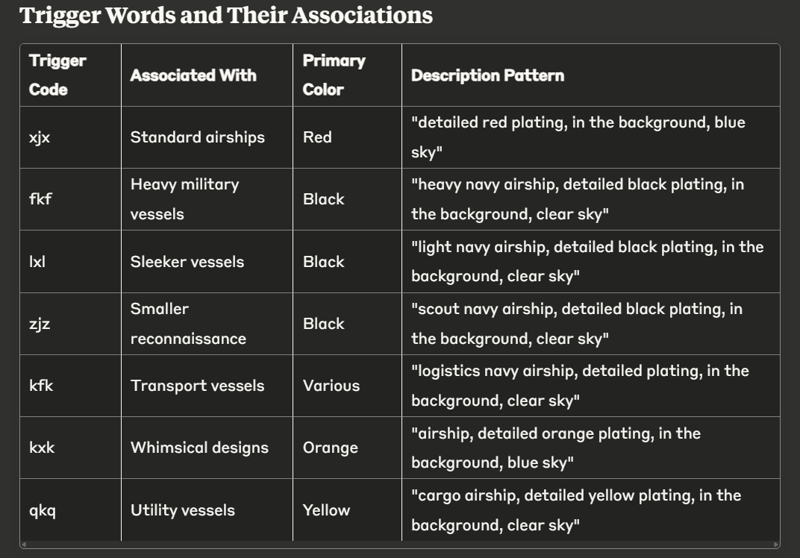Verified: 9 months ago
SafeTensor
The FLUX.1 [dev] Model is licensed by Black Forest Labs. Inc. under the FLUX.1 [dev] Non-Commercial License. Copyright Black Forest Labs. Inc.
IN NO EVENT SHALL BLACK FOREST LABS, INC. BE LIABLE FOR ANY CLAIM, DAMAGES OR OTHER LIABILITY, WHETHER IN AN ACTION OF CONTRACT, TORT OR OTHERWISE, ARISING FROM, OUT OF OR IN CONNECTION WITH USE OF THIS MODEL.
Analysis of Airship Image Generation Model
Introduction
This report analyzes a dataset of prompts used to train a generative image model specialized in creating airship/spacecraft imagery. The model appears to be focused on creating anime-style fantastical airships with various designs, color schemes, and environmental settings.
Prompt Structure
The typical prompt follows this pattern:
anime [TRIGGER CODE] [TYPE] airship, detailed [COLOR] plating, in the background, [SKY TYPE] ([NUMBER])
Where:
TRIGGER CODE: A three-letter code (e.g., xjx, fkf, lxl) that specifies particular characteristics
TYPE: Optional descriptor of the airship's function (e.g., heavy, light, scout, cargo)
COLOR: The primary color scheme of the airship
SKY TYPE: The background environment (typically "blue sky" or "clear sky")
NUMBER: Appears to be an identifier in parentheses, possibly representing specific examples/iterations

Visual Characteristics by Trigger Word
xjx (Red Standard Airships)
Primarily steampunk-style with red and gold coloration
Often feature intricate mechanical details (gears, pipes, propellers)
Frequently described as "fantastical" or "whimsical"
Typically shown against blue skies with white clouds
Sometimes have text/names on their sides
Range from sleek to elaborate multi-layered designs
fkf (Heavy Navy Airships)
Military/battleship aesthetic with dark coloration
Often depicted with weapons, turrets, and antennas
Frequently shown with explosions or in combat scenarios
Many have identification numbers or text (e.g., "AKPER", "XFK", "ARTNASIL")
Generally more serious/menacing than other types
Often shown with reflections on water below
lxl (Light Navy Airships)
Sleeker, more aerodynamic designs compared to fkf
Still military in nature but less heavily armed
Often feature illuminated windows or panels
Frequently shown at night or during sunrise/sunset
Many display registration numbers or text identifiers
Described as "floating" or "hovering" above clouds or water
zjz (Scout Navy Airships)
Smaller, more maneuverable vessels
Often shown in action scenes
Typically have numerical identifiers (e.g., "X178", "XK3")
Described as "sleek" and "aerodynamic"
Usually depicted in motion rather than stationary
kfk (Logistics Navy Airships)
Utilitarian designs focused on transport
Various color schemes but often with dark base colors
Often have identification codes (e.g., "1KP", "XAP")
Less ornate than other categories
Sometimes resemble trains or cargo carriers
kxk (Orange Whimsical Airships)
Highly stylized, cartoonish designs
Often described as having "tentacle-like" features or animal-like qualities
Some have humanoid features (faces, arms, legs)
More playful and fantastical than the military variants
Frequently described as "whimsical" or "steampunk-style"
qkq (Yellow Cargo Airships)
Primarily orange/yellow utility vessels
Often labeled with text like "AIRMTH" or "XFSHP"
Functional design elements suggesting cargo capacity
Sometimes resemble submarines or more conventional aircraft
Less ornate than the standard or whimsical types
Environmental Settings
The model appears capable of generating airships in various atmospheric conditions:
Clear blue skies with scattered clouds (most common)
Sunset/sunrise with vibrant orange and pink hues
Night skies with stars and moonlight
Reflected on water surfaces
Various cloud formations and densities
Combat scenarios with explosions and smoke
Notable Style Elements
Steampunk Aesthetic: Many airships feature Victorian-era steam-powered elements combined with futuristic technology
Anime Influence: The "anime" prefix in all prompts suggests a stylized, animated appearance
Mechanical Detail: Consistent emphasis on intricate mechanical components (gears, pipes, propellers)
Color Coding: Strong correlation between trigger codes and color schemes
Functional Design: Different vessel types have design elements matching their supposed function
Text Elements: Many airships feature text, numbers, or identifying marks
Reflections: Frequent use of reflective surfaces below the airships
Observed Limitations
The model appears to be specialized primarily for airships/spaceships and may not generalize well to other subjects
The color palette seems limited to specific schemes based on the trigger codes
Backgrounds are relatively consistent (sky, clouds) with limited variation
All prompts begin with "anime," suggesting a specific stylistic constraint
Conclusion
This generative image model demonstrates specialized capabilities for creating diverse airship/spacecraft designs in an anime-inspired style. The use of specific trigger codes (xjx, fkf, etc.) appears to control major visual characteristics including vessel type, color scheme, and general aesthetic. The model shows particular strength in creating detailed mechanical components and varied atmospheric conditions.
The prompt structure reveals a systematic approach to controlling the generated output, with clear patterns connecting trigger codes to specific visual outcomes. The model appears to have been trained on a dataset focused exclusively on fantastical airborne vessels with particular attention to steampunk and futuristic sci-fi aesthetics.

